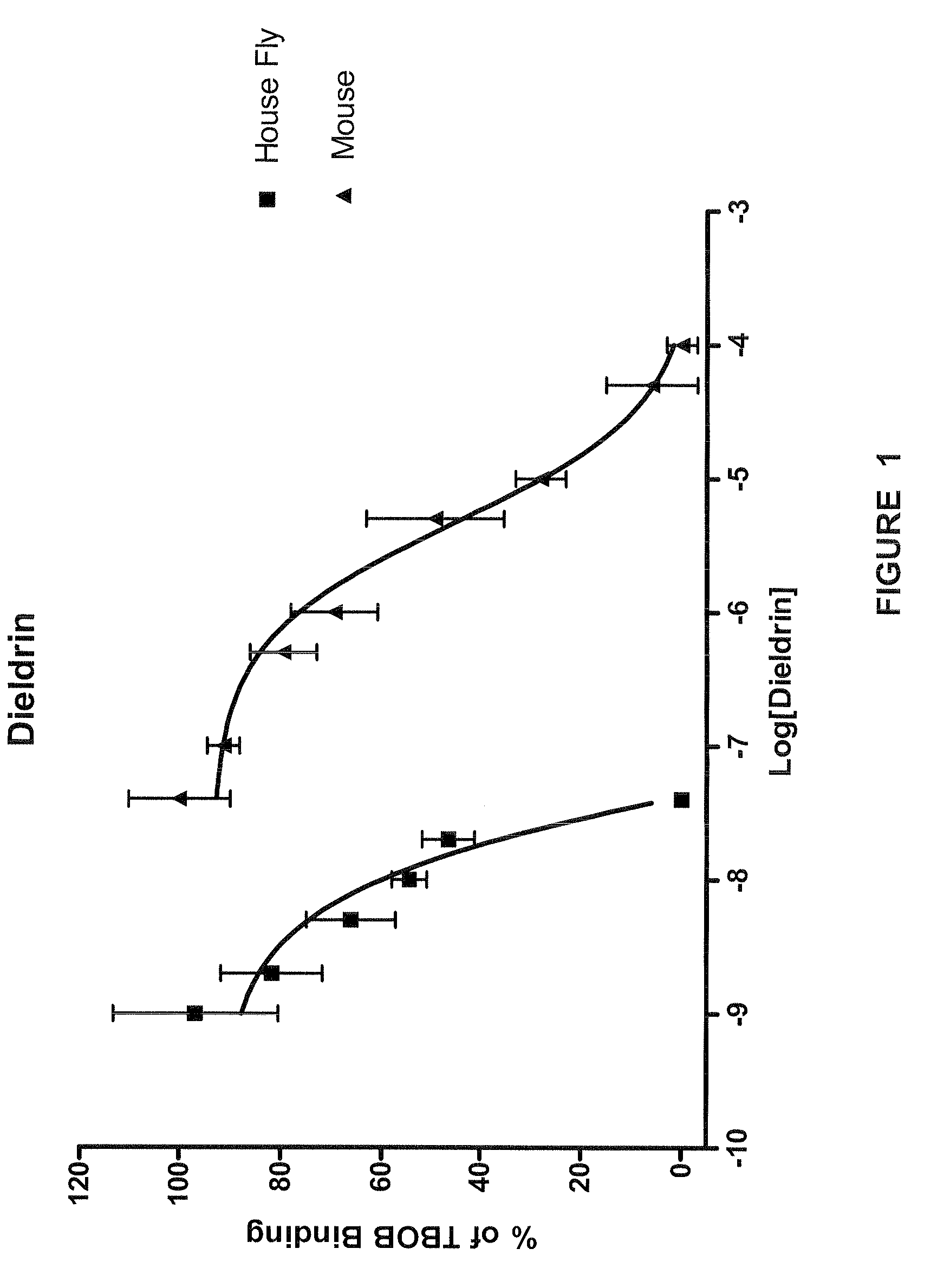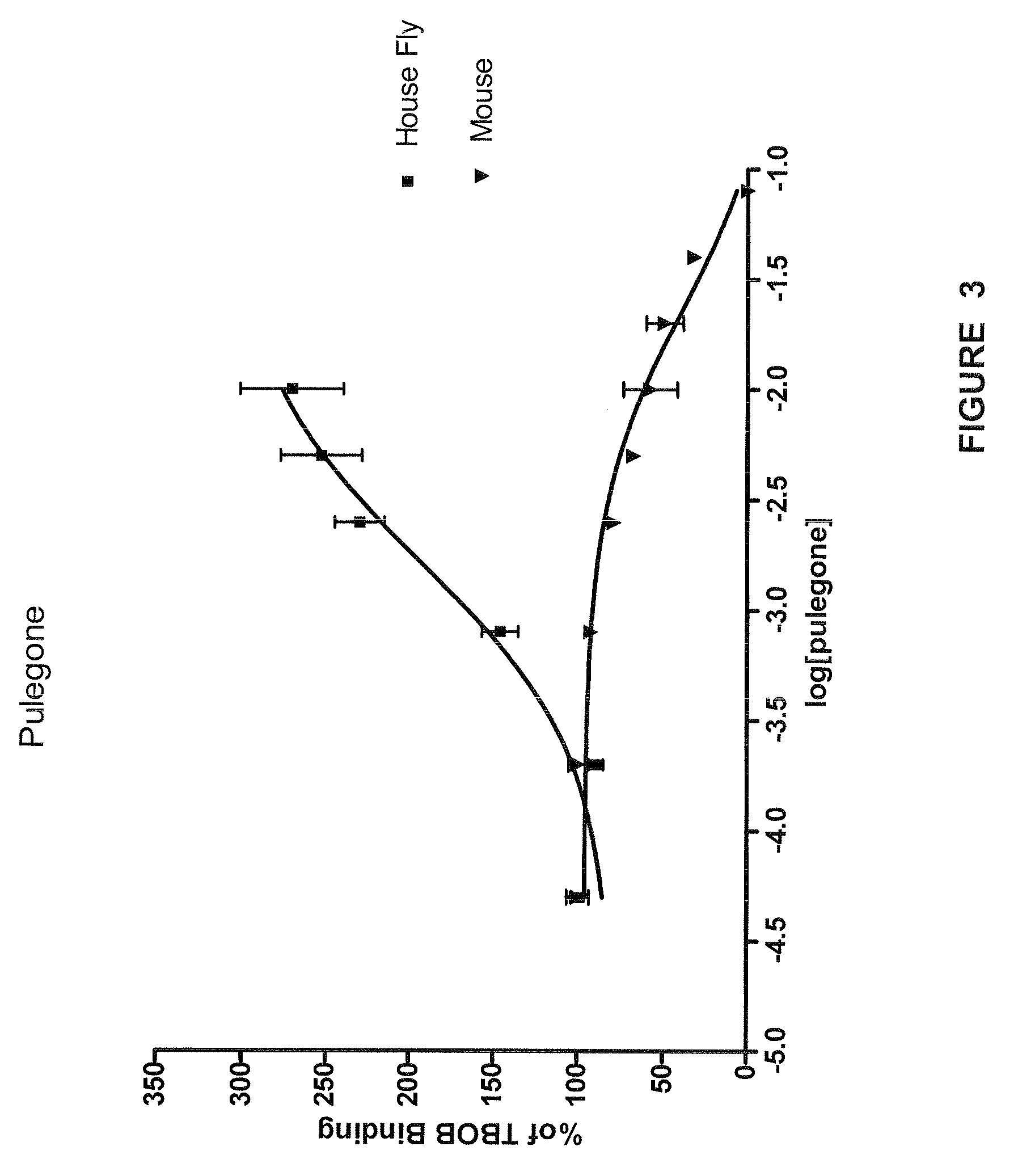Pesticidal methods and compositions for modulating gaba receptors
a gaba receptor and composition technology, applied in the field of gaba receptor structure and function, can solve the problems of reducing crop quality, reducing crop yield, and reducing crop losses, and achieving good plant tolerance and favorable safety for warm-blooded animals
- Summary
- Abstract
- Description
- Claims
- Application Information
AI Technical Summary
Benefits of technology
Problems solved by technology
Method used
Image
Examples
example 1
[0124][3H]-TBOB Assay. In this study, five monoterpenoids (Pulegone, Thymol, Alpha-terpineol, Linalool and Carvacrol) were investigated to determine their modulation effects on [3H]TBOB (t-butylbicycloorthobenzoate) binding to housefly GABA (Gamma-aminobutyric acid) receptors.
[0125]Materials and Methods
[0126]Materials:
[0127]The five monoterpenoids (pulegone, thymol, alpha-terpineol, linalool and carvacrol) were purchased from Sigma-Aldrich Chemical Co., as was the picrotoxin. The [3H]-TBOB was purchased from Amersham Biosciences.
[0128]Tissue Preparation:
[0129]House fly heads (200) were homogenized in 10 mM tris-HCL buffer (pH 7.5) containing 0.25M sucrose (buffer A) with a glass homogenizer. The homogenate was centrifuged at 1,000×g for 5 minutes. The supernatant was filtered by four layers cheesecloth and centrifuged at 25,000×g for 30 minutes. The supernatant was discarded, and the pellet was homogenized and resuspended in buffer A for 30 minutes. The suspension was centrifuged at...
example 2
36Cl— Uptake Assay
[0133]Cockroach CNS Membrane Microsacs Preparation: Thoracic and abdominal ganglia were removed from 30 American cockroaches and homogenized in 8.0 ml ice-cold buffer of the following composition (in millimoles per liter): NaBr, 145; KBr, 5.0; MgSO4, 1.0; Ca(NO3)2, 1.0; D-glucose, 10.0; N-2-hydroxyethylpiperazine-N′-2-ethanesulphonic acid (HEPES), 10.0 (adjusted to pH 7.5). The homogenate was centrifuged in 1.0 ml aliquots at 10,000×g for 20 min, and the pellets were re-suspended in buffer, re-centrifuged and finally re-suspended in buffer for assaying GABA-activated 36Cl— uptake.
[0134]Cockroach GABA-activated 36Cl— Uptake: Aliquots (200 μl) of this microsac preparation were incubated at 30° C. for 3 min after which 150 μl of a solution of 36Cl— (0.2 μCi ml-l; specific activity 580 μCi mmol−1) containing 1 μM GABA was added. Candidate monoterpenoids were incubated with the tissue sample for 3 min before addition of the solution containing 36Cl— and GABA. To stop th...
PUM
 Login to View More
Login to View More Abstract
Description
Claims
Application Information
 Login to View More
Login to View More - R&D
- Intellectual Property
- Life Sciences
- Materials
- Tech Scout
- Unparalleled Data Quality
- Higher Quality Content
- 60% Fewer Hallucinations
Browse by: Latest US Patents, China's latest patents, Technical Efficacy Thesaurus, Application Domain, Technology Topic, Popular Technical Reports.
© 2025 PatSnap. All rights reserved.Legal|Privacy policy|Modern Slavery Act Transparency Statement|Sitemap|About US| Contact US: help@patsnap.com



